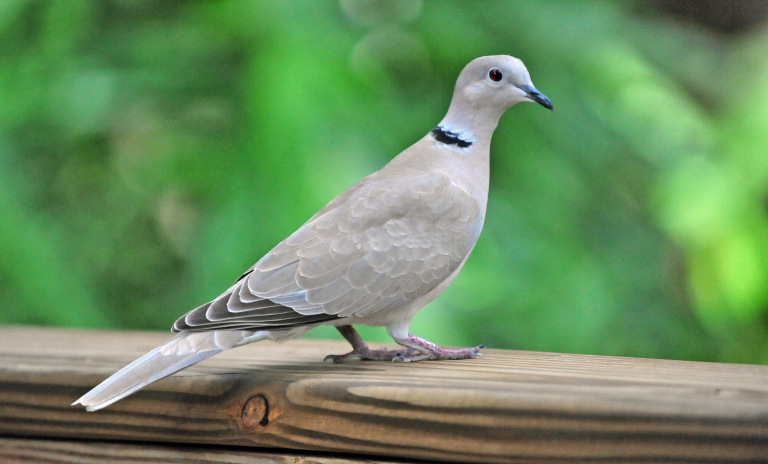
Backyard Dove Hunting with Judo Point Arrows?

by Carrie Wilson
6-8-2017
Website
Question: I am a recently minted homeowner and my neighborhood is overrun by Eurasian doves. For fun, I would like to do some recurve bow hunting for them with judo point arrows when the season opens later this year. I know that the statute states, “No discharge of firearms or any deadly weapon within 150 yards of a residence.” However, can you please tell me if using judo point arrows with flu-flu fletching would be considered deadly? My plan is to hunt from an elevated position such that the arrows strike within my own backyard. (Anonymous)
Answer: Because you would be hunting, the statute would apply to you even if your bow and arrows were not deadly weapons. “It is unlawful for a person, other than the owner, person in possession of the premises, or a person having the express permission of the owner or person in possession of the premises, while within 150 yards of an occupied dwelling house, residence, or other building…, to either hunt or discharge a firearm or other deadly weapon while hunting” (Fish and Game Code, section 3004(a)). To lawfully hunt in your back yard, you would need to get permission from every owner or occupant of dwellings within 150 yards, and then make sure there are no local ordinances or rules that prohibit hunting in your neighborhood, and then make sure your archery equipment complies with California Code of Regulations Title 14, section 354. You will find this section if you go to page 28 in the current California Mammal Hunting Regulations booklet.
Obtaining gaper clams?
Question: I have a question regarding digging for and obtaining gaper clams. I know the daily bag limit is 10 clams per person. Now, I’m pretty sure you know how hard it is to dig for these clams, so if I’m clamming with my friends, can we assist each other to reach our limits? I’m confused because last year while with friends digging for clams, we were checked by a Fish and Wildlife officer. He just checked our licenses, counted the total quantity that my friends and I had acquired and then sent us on our way. However, this year I heard you can’t help each other. Did they change the regulation or was it always that way? I would hate to get a ticket due to ignorance. (Nam T.)
Answer: As long as all of you were in possession of valid fishing licenses, it would be permissible to help each other as long as each person is retrieving their own clams and each person is involved in the entire process of digging for their own clams. Where you could run into a problem is if one person digs up and retrieves more than 10 clams and “shares” his additional catch among the group. Once a person has dug up and possesses a daily bag limit, he or she must stop assisting other members of the group. This is important because if the individual possesses a limit, he or she is no longer able to attempt to take any more.
Before setting out to harvest gaper clams or any other species of shellfish, please first check the California Department of Public Heath shellfish hotline at (800) 553-4133. This recording is available 24/7, is updated frequently and will tell you about any health concerns or health-related harvest closures in effect for shellfish and finfish in California ocean waters.
Fishing with live bait in Lake Mendocino?
Question: Can I buy minnows in Lake County (Clearlake Outdoors) and then use them as bait in Lake Mendocino? I have tried to read the regs but they are soooo confusing. (William W.)
Answer: Remember, the term “minnows” is used for a number of baitfish species. Golden shiner, fathead minnow, red shiner, mosquitofish, longjaw mudsucker and staghorn sculpin are authorized live bait for Lake Mendocino. The regulations you are asking about can be found in the 2017 Freshwater Sport Fishing Regulations booklet under CCR Title 14, section 4.25.
Kelp collecting for a science class?
Question: I am a science teacher planning a unit on photosynthesis, and I’d like to include a few pieces of kelp in the kids’ exploratory activities. They’ll be looking at leaves and at other aquatic algae, too. Before I go collecting, is it even legal to go get some kelp fronds from the beach wrack? If so, where it is legal to collect? (Kelly T., Pacific Grove)
Answer: Take of kelp is legal, as long as you’re not in a Marine Protected Area (MPA) that prohibits the take of kelp. The daily bag limit for recreational harvesters of marine algae is 10 pounds wet weight in the aggregate. Recreational harvesters are prohibited from harvesting or disturbing eelgrass (Zostera species), surfgrass (Phyllospadix species) and sea palm (Postelsia palmaeformis).
Carrie Wilson is a marine environmental scientist with the California Department of Fish and Wildlife. While she cannot personally answer everyone’s questions, she will select a few to answer each week in this column. Please contact her at CalOutdoors@wildlife.ca.gov.
Website Hosting and Design provided by TECK.net